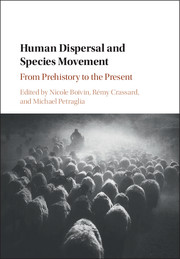Book contents
- Frontmatter
- Contents
- List of text boxes
- List of figures
- List of tables
- List of contributors
- Preface
- I Introduction
- II Origins: Species Movements in the Pleistocene
- III Across the water: Species movements by Coast and Sea
- IV Complexity: Species Movements in the Holocene
- V Invasion: The Movement of Invasive and Disease Species
- 15 Invasive eusocieties: Commonalities between ants and humans
- 16 Invasives, aliens, and labels long forgotten: Toward a semiotics of human-mediated species movement
- 17 Multiple time scales for dispersals of bacterial disease over human history
- 18 Early malarial infections and the first epidemiological transition
- 19 The globalisations of disease
- 20 Modern day population, pathogen and pest dispersals
- Index
- Plate section
- References
19 - The globalisations of disease
from V - Invasion: The Movement of Invasive and Disease Species
Published online by Cambridge University Press: 04 May 2017
- Frontmatter
- Contents
- List of text boxes
- List of figures
- List of tables
- List of contributors
- Preface
- I Introduction
- II Origins: Species Movements in the Pleistocene
- III Across the water: Species movements by Coast and Sea
- IV Complexity: Species Movements in the Holocene
- V Invasion: The Movement of Invasive and Disease Species
- 15 Invasive eusocieties: Commonalities between ants and humans
- 16 Invasives, aliens, and labels long forgotten: Toward a semiotics of human-mediated species movement
- 17 Multiple time scales for dispersals of bacterial disease over human history
- 18 Early malarial infections and the first epidemiological transition
- 19 The globalisations of disease
- 20 Modern day population, pathogen and pest dispersals
- Index
- Plate section
- References
Summary
Abstract
Several disciplines – including genetics, bioarchaeology, and documentary history – contribute to the stories we tell of humankind's major infectious diseases over the past 100,000 years. In some cases, these diseases have dispersed globally because, as obligate pathogens, they have gone wherever their human hosts have gone. Thus, tuberculosis, leprosy, smallpox, syphilis, and HIV/AIDS have traveled along paths (and via technologies) that have moved human populations to all five inhabited continents and Oceania. In other cases, diseases have moved because humans transported micro-environments that brought pathogens along; this would describe the histories of malaria, plague, and cholera. However, many aspects of these narratives are still under debate, including their chronologies and geographic trajectories. This essay will not attempt to settle those debates, but, rather, suggest why the points of debate matter. How does the story change if we alter the chronology by several thousand years, or propose different geographical routes?
Key words: global health, bioarchaeology, historical method, phylogenetics, aDNA
GOING GLOBAL
What turns a handful of human-pathogen encounters (a small outbreak) into a global human disease, affecting millions of people around the world? Answering that question in the present day seems very simple: jet travel. Intercontinental airborne transmission has indeed been a critical component of the latest diseases posing global threats (see Tatem, this volume), including SARS, MERS, and, most dramatically, HIV/AIDS, whose recognition by the biomedical establishment in 1981 was due to its presentation in middle-class urban patients in the United States several decades after the disease had taken root in populations in West Central Africa (Pepin 2011; Faria et al. 2014). “Sexual tourism” facilitated by jet travel was an important part of the global spread of HIV/AIDS in the 1970s and ’80s. Yet of the global diseases to be examined in this essay, HIV/AIDS is the only one whose historical globalisation is a product of the jet age. All the others were globalized by the early twentieth century, if not hundreds of years before.
In asking what facilitates one disease to become global while others remain localized to specific environments, many factors must be assessed. The microbiologist will look at the level of the micro organism, assessing the virulence of the pathogen, or its relative success in transmission from host to host.
- Type
- Chapter
- Information
- Human Dispersal and Species MovementFrom Prehistory to the Present, pp. 494 - 520Publisher: Cambridge University PressPrint publication year: 2017
References
- 8
- Cited by

